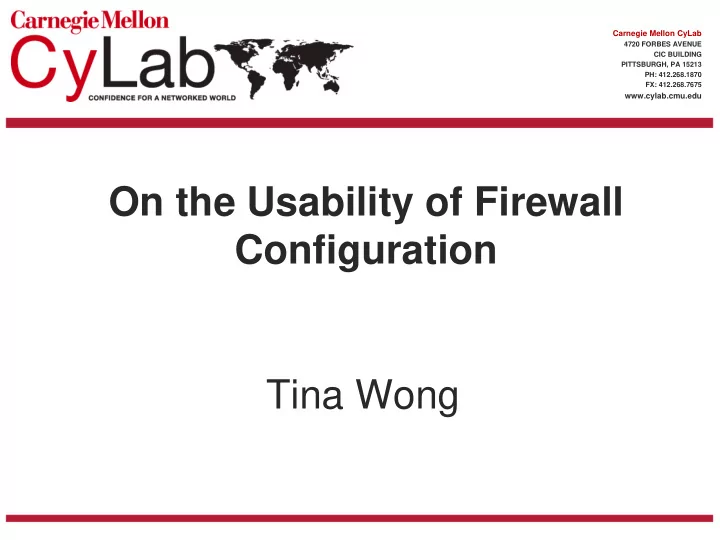

Carnegie Mellon CyLab 4720 FORBES AVENUE CIC BUILDING PITTSBURGH, PA 15213 PH: 412.268.1870 FX: 412.268.7675 www.cylab.cmu.edu On the Usability of Firewall Configuration Tina Wong July 27 2006 CyLab IACBP 1
Firewalls • Firewalls are used to protect enterprise internal networks • Mistakes can lead to serious security, financial and performance implications July 27 2006 CyLab IACBP 2
Problems • A quantitative study on firewalls in 37 enterprises found that all of them have some form of misconfigurations • “Complex rule sets are apparently too difficult for administrators to manage efficiently” • [Wool 2004] July 27 2006 CyLab IACBP 3
Why? • Firewall configuration is a complex and error-prone task • Configuration languages are like assembly languages – low-level and vendor-specific • A single change in one firewall can affect the whole network July 27 2006 CyLab IACBP 4
Packet Filters Also called Access Control Lists (ACLs) access-list name {permit|deny} protocol source dest access-list 101 deny ip 10.0.0.0/8 any access-list 101 deny ip 127.0.0.0/8 any access-list 101 deny ip 192.168.0.0/16 any access-list 101 permit any July 27 2006 CyLab IACBP 5
6 What about GUI? CyLab IACBP July 27 2006
Preference on CLI over GUI • Administrators strongly prefer CLIs over GUIs • Perceived CLIs as faster, more flexible, trustworthy, reliable, robust and accurate • GUIs can sometimes hide important details or are buggy • Administrators face risks in relying solely on GUIs • “with a plain text editor like vi, the user (administrator) can be confident that what you see is what you get”. • [Botta et al 2007] [Haber & Bailey 2007] July 27 2006 CyLab IACBP 7
Contributions • Models to systematically measure where the complexity lies in firewall configuration – places which lead to heavy mental burdens • Apply the models to real configuration files from production networks • Propose tools that can integrate into the configuration process without replacing the CLI as the main user interface July 27 2006 CyLab IACBP 8
Lexical Complexity • Program Vocabulary n – Sum of number of distinct operators and operands • Program Volume v – v = N * log (n) – N is the total number of operators and operands • Large vocabulary and/or volume size means higher mental demands on the administrator July 27 2006 CyLab IACBP 9
Example access-list 101 deny ip 10.0.0.0/8 any access-list 101 deny ip 127.0.0.0/8 any access-list 101 deny ip 192.168.0.0/16 any access-list 101 permit any • access-list is a keyword thus an operator • others are parameters thus operands July 27 2006 CyLab IACBP 10
Structural Complexity • Measures the number of independent paths in firewall configurations network-wide • G = <V,E,R> – Each firewall rule is a vertex – There is an edge e between v1 and v2 if (1) set of packets filtered by v1 intersects with those of v2, or (2) v1 and v2 belong to same packet filter, or (3) v1 and v2 are topologically connected • SC = E – V + 2p July 27 2006 CyLab IACBP 11
Example firewall 1 firewall 2 Corporate Network Internet access-list 401 deny tcp 1.2.0.0/16 any Mail Web Server Server access-list 301 deny tcp 1.2.3.0/24 any access-list 301 accept tcp any any July 27 2006 CyLab IACBP 12
Study • Data from a university campus network • > 50 routers but focus on two border routers and two core routers which implements most of it’s firewall functions • Conclude that should design visualizations to alleviate mental models for the most complex parts of firewall configurations – IP addresses, names, interfaces and packet filter interactions July 27 2006 CyLab IACBP 13
IP addresses • IP addresses are copied everywhere in firewall configuration • When writing or reading configuration, intent should be clear – internal subnets, private addresses, known malicious networks, etc • Visualizations fill in details the administrators may not remember – Show a global picture of how network treats the addresses July 27 2006 CyLab IACBP 14
Names • Ideal case is a central repository for all packet filters – but “the network is the database” • Packet filters with same name but semantically different • Packet filters with similar names – e.g. Bogon vs bogon – Multiple administrators with different coding style • Topological order July 27 2006 CyLab IACBP 15
Interactions • Packet filters for HTTP, SMTP, DNS, and NTP services – Defined on border routers on outgoing traffic for accounting purposes – Also on incoming traffic for port exceptions • Visualize to keep with mental images of – network topology and interfaces – direction of packet filter applications July 27 2006 CyLab IACBP 16
Information Linking • [Maclachlan et al 2008] uses explicit linking to coordinate multiple views of related information • Tie main CLI to related information – Administrators only work on a small part of firewall configuration at a time – But large amount of relevant information – Explicitly link them in side windows – An IDE for firewall configuration July 27 2006 CyLab IACBP 17
Future Work • Integrate analytics into the configuration environment • Prototype some of these visualization concepts • Evaluate them with user studies • Apply complexity models to routers (e.g. interface definitions, routing protocols, routing policies) July 27 2006 CyLab IACBP 18
References • [Wool 2004] A. Wool, A Quantitative Study of Firewall Configuration Errors. IEEE Computer, June 2004 • [Haber & Bailey 2007] E. Haber and J. Bailey, Design Guidelines for System Administration Tools Developed through Ethnographic Field Studies. Proceedings of CHIMIT, March 2007. • D. Botta et al, Towards Understanding IT Security Professionals and Their Tools. Proceedings of SOUPS, July 2007. • P. McLachlan et al, LiveRAC: Interactive Visual Exploration of System Management Time-Series Data, In CHI, April 2008. July 27 2006 CyLab IACBP 19
20 Questions? Thank you CyLab IACBP July 27 2006
Recommend
More recommend